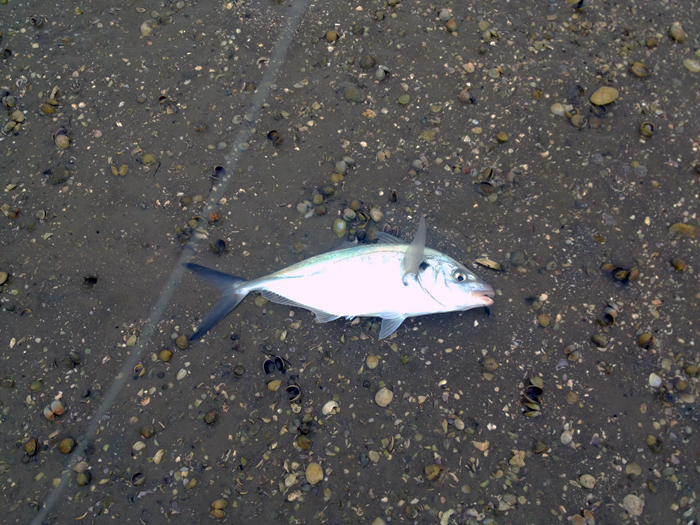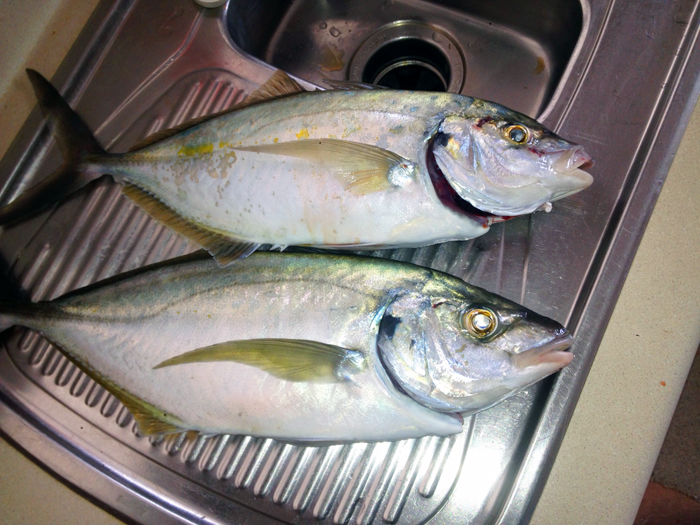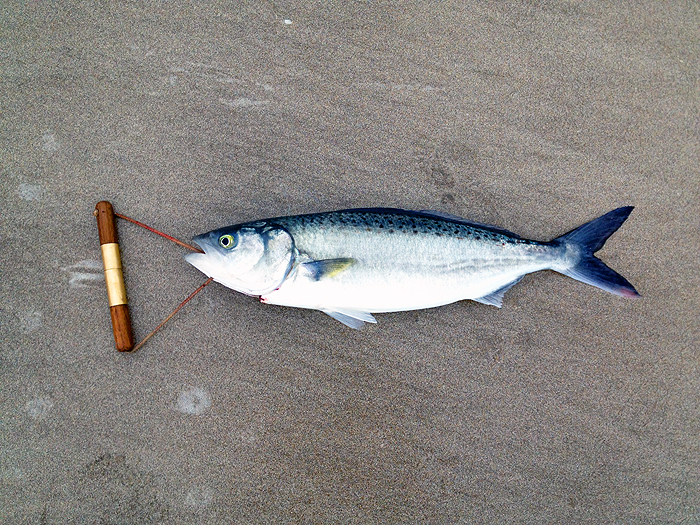

Catch Fish with
Mike Ladle
Information Page
SEA FISHING
For anyone unfamiliar with the site always check the FRESHWATER, SALTWATER and TACK-TICS pages. The Saltwater page now extends back as a record of over several years of (mostly) sea fishing and may be a useful guide as to when to fish. The Freshwater stuff is also up to date now. I keep adding to both. These pages are effectively my diary and the latest will usually be about fishing in the previous day or two. As you see I also add the odd piece from my friends and correspondents if I've not been doing much. The Tactics pages which are chiefly 'how I do it' plus a bit of science are also updated regularly and (I think) worth a read (the earlier ones are mostly tackle and 'how to do it' stuff).
Trevally from the shore.
Once again I'm forced to use material from one of my pals to produce the blog page. However, as always, it's interesting stuff. I learn a lot from how other people fish and letters from Alan Bulmer in New Zealand are particularly productive:-
Hi Mike,
Trust this note finds you in the best of everything and that the woeful UK weather has improved enough for you to wet a line. As you know, we went down to Whangamata on Good Friday and returned today. Hamish had to be back for a social commitment which meant that we had to travel back early in the day rather than after dark. This meant that I only got to fish the estuary yesterday but what a fascinating session it was.
Low tide was scheduled for 4.00 pm and the Maori calendar showed a black, tight lipped fish with the words BAD printed below it. Perfect as whenever it says BAD I always seem to do well. Learning my lesson from the blank session two weeks ago, I checked the SwellMap forecast, discovered that there was a large tidal variation and rigged up for a strong outgoing tidal flow. The weather was ideal for fishing. Overcast conditions, light zephyr from the East gusting 7 knots with the mercury hovering around 21 degrees C.
I ambled across the mudflats around 2.00 pm and there was very little activity. A couple of power boats chugged slowly back to the marina but no jet skiers or noisy activity to frighten the fish. The few seagulls present all appeared to be in a state of torpor and showed little interest in trying to dissuade me from crossing their domain. When I finally reached the main channel it looked in excellent condition and the visibility was exceptional. Mullet were moving in the margins and it felt like something was going to happen any minute.
I tied on a ¼ oz. jig head, threaded on a 2” PowerBait minnow and angled a cast slightly upstream from my normal spot. I’d got the weight exactly right as when I wound in the slack and allowed the braid to sit on the tip of my index finger there was a constant tap-tapping as the jig head bounced gently across the bottom in its shoreward arc. First cast was too short but by cast four I’d got the distance spot on and settled into a steady rhythm. I then noticed out of the corner of my eye that there was a large bow wave moving steadily towards me from below. It swerved out and headed into the main channel in a shower of bait fish. A pelagic on the prowl. “This looks promising!” I muttered to no one in particular.
Cast five was a beauty. No flapping of the soft bait as it headed into the breeze and a perfect entry on the far side of the foam line. The lure sank quickly and I’d thrown a mend and removed the slack by the time it started tap-tapping seductively. About a third of the way to the shore I felt the line draw tight and struck hard. Within a nanosecond whatever the hook had attached itself to took off at high speed towards the far shore. The rod bucked down hard in response to the extra weight. 30 meters of line squealed from the spool in an instant. I applied side and managed to turn the fish's head so that it started to fight parallel to the shore rather than perpendicular to the current. The steady thrumming, the dogged fight in between searing runs of 20 – 30 metres parallel to the shore screamed trevally and a good one at that. Soon after I managed to spot the fish as it sprinted downstream with the current and there was no doubt that it was a decent trevally. It took five minutes of “too-ing and fro-ing” to beach the 3 lb. fish and dispatch it for dinner.
I covered the fish with a wet towel and, as I checked my lure, “Cedric” the opportunistic black backed gull arrived with a glint in his eye and a grin which clearly signalled his intent. He sat nonchalantly about 30 metres away but I was under no illusion as to what would happen next having been the victim of his high speed towel lifting before. I headed back to the channel about 20 metres downstream of where I’d hooked the fish, one eye fixed on Cedric and one eye on where I was going to lob the lure.
Within three casts I was in again. Striking as the line drew tight on the tip of my index finger. This fish gave a performance almost identical to the first and I was surprised to find when I beached it that the hook was impaled in its jowl and that it had been recently hooked before as the skin near the maxillary was torn and flapping freely. Coincidentally the hook was set directly behind the tear. I’m picking that the hook went through the hole in its lip and hit the jowl when I struck. Again I opted to keep the almost 3 lb. fish for dinner and wrapped it in the towel alongside its compatriot. This got Cedric highly agitated and he cleared his lungs, squawking stridently in approval. I’d have to be doubly careful now!
Decision time. Should I go back to my original spot or head downstream and risk an attack from Cedric? Opting for my original spot I checked the lure and send it arching across the channel. It entered the water nicely and within seconds was on the bottom bouncing seductively. It would have travelled no more than 10’ when it was absolutely monstered. I struck hard to set the hook and the fish engaged turbochargers and took off. 10, 20, 30 … 50 metres of line evaporated off the spool as the drag clicker squealed in angst. This fish was much bigger and the rod was bucking angrily as the fish clearly stated its intent. I managed to turn its head for an instant before it headed further across the channel wrenching still more braid off against a heavy drag setting. I was in trouble now as I could feel the tail thwacking the line and knew that if it turned and headed downstream then it would go down the far side of a mooring buoy and I’d be unable to prevent a bust off. I applied thumb pressure and side. Slowly it began to turn parallel to the shore, only to then spin on its tail and head further away, thumping the line with its tail mercilessly. I was not in control at all. Again I tried side and the line broke with a sharp ping. “Oh bother!!!” I proclaimed (or similar meaning expletives), just in time to turn and see Cedric starting to lift the towel. Quickly forgetting the loss I charged towards Cedric and shooed him away. The cunning sod did an aerial circuit and landed about 30 metres away, glowering in my general direction.
I checked the trace and it had broken at the loop knot. The fraying on the line where the trevally had been beating it with its tail was at least 65 cm from the knot which gives some idea as to how big the fish was. I immediately tied on a new trace and then noticed that a rain squall was building further up the estuary so I opted to head home early. Three fish in 45 minutes, including one munter. Awesome session. In hindsight I probably should have changed the trace after two stroppy fish to prevent such stress breakages but one never remembers to do this in the heat of the battle. This reinforces what I’ve known for years that big trevally flood into Whangamata estuary in Autumn as soon as the weather starts to turn chilly in the evenings. I didn’t fish Whangamata in April last year but caught a lot of trevally in April 2011 as soon as the evenings cooled off and the boat traffic died down.
Must go as have got a few chores to complete before going out. Best regards to all. Tight lines and best wishes,
Alan Bulmer.
Thanks Alan! The 'Maori calendar' is supposed to predict the quality of the fishing but like all these fairy tales it does no such thing. Later on Alan had a nice kahawai from a different beach so I've added the picture. The mention of 'chores' reminds me I've a lot of gardening to catch up with if I'm to go fishing tomorrow. Of course the weather is still really cold but perhaps I'll catch something this time?
If you have any comments or questions about fish, methods, tactics or 'what have you!' get in touch with me by sending an E-MAIL to - docladle@hotmail.com
Trevally.

Dinner.

Kahawai.
